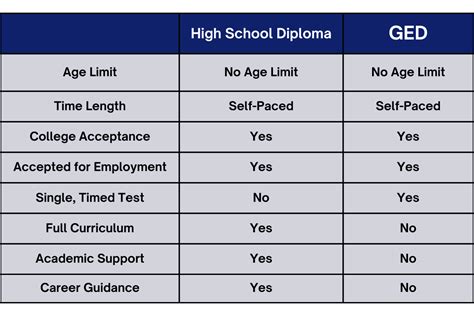In today’s competitive job market, having a high school diploma or equivalent is essential for many careers. But what if you don’t have a traditional high school diploma? Two options are available to you: the General Educational Development (GED) test and a high school diploma.

What is the GED?
The GED is a series of five tests that measure your academic skills in reading, writing, mathematics, science, and social studies. It is designed to be equivalent to a high school diploma and is accepted by most colleges and employers.
What is a High School Diploma?
A high school diploma is a document that certifies that you have completed a course of study that meets the requirements of your state’s education system. It is typically earned after four years of high school.
Which Path is Right for You?
The best path for you depends on your individual circumstances and goals. If you are looking for a quick and affordable way to get your high school equivalency, the GED may be a good option. If you are planning on going to college or pursuing a career that requires a traditional high school diploma, then getting a high school diploma may be the better choice.
Cost
The cost of the GED varies depending on the state in which you take it. However, it is generally less expensive than getting a high school diploma. The average cost of the GED is around $120, while the average cost of a high school diploma is around $10,000.
Time Commitment
The time it takes to get your GED or high school diploma depends on your individual circumstances. However, most people find that it takes about six months to a year to prepare for and take the GED. It typically takes four years to complete a high school diploma.
Acceptance
The GED is accepted by most colleges and employers. However, some colleges and employers may prefer a traditional high school diploma.
Benefits of the GED
- Quick and affordable: The GED is a quick and affordable way to get your high school equivalency.
- Flexible: The GED can be taken at your own pace and on your own schedule.
- Accepted by most colleges and employers: The GED is accepted by most colleges and employers.
Benefits of a High School Diploma
- Traditional path to college and career: A high school diploma is the traditional path to college and career.
- More college and career options: A high school diploma opens up more college and career options.
- Higher earning potential: People with a high school diploma earn more money than those with only a GED.
Table 1: GED vs. Diploma: Cost
| Credential | Average Cost |
|---|---|
| GED | $120 |
| High School Diploma | $10,000 |
Table 2: GED vs. Diploma: Time Commitment
| Credential | Time Commitment |
|---|---|
| GED | 6 months to a year |
| High School Diploma | 4 years |
Table 3: GED vs. Diploma: Acceptance
| Credential | Acceptance |
|---|---|
| GED | Most colleges and employers |
| High School Diploma | Traditional path to college and career |
Table 4: GED vs. Diploma: Benefits
| Credential | Benefits |
|---|---|
| GED | Quick and affordable, flexible, accepted by most colleges and employers |
| High School Diploma | Traditional path to college and career, more college and career options, higher earning potential |
Conclusion
Ultimately, the best way to decide which path is right for you is to consider your individual circumstances and goals. If you are looking for a quick and affordable way to get your high school equivalency, the GED may be a good option. If you are planning on going to college or pursuing a career that requires a traditional high school diploma, then getting a high school diploma may be the better choice.
Additional Tips
Here are some additional tips to help you make the best decision for your future:
- Talk to your family and friends about your goals.
- Research different colleges and careers.
- Visit a GED testing center or high school.
- Take a practice GED test.
- Talk to a guidance counselor or career counselor.
